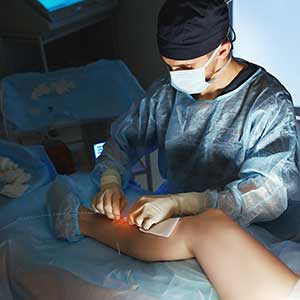
Many people think varicose veins are just a cosmetic concern and the only reason to treat them is vanity. It’s true that varicose veins are generally harmless (yet unsightly). But for some people, they could be warning signs of serious underlying health issues.
Varicose veins develop when one-way valves responsible for moving blood through the veins and towards the heart become weak or damaged. This causes blood to pool inside the veins, resulting in the twisting and bulging of the veins.
Varicose Veins vs. Spider Veins
Varicose veins are not the same as spider veins (telangiectasias)—those small, thin blood vessels that appear on the skin. Spider veins can be red, blue, or purple in color, and take on a shape that resembles a spider web (which is how they earned their name). Spider veins are harmless themselves, but can be a symptom of poor circulation or a sign of increased risk for varicose veins.
Varicose veins are more prominent—bulging out from just beneath the surface of the skin. They may also appear swollen, twisted, or engorged—almost like they might burst. Although they can develop anywhere in the body, they are most often found on the legs and ankles and can be blue or dark purple in color.
Risk Factors and Stats for Varicose Veins
- 23% of people in the US are affected by varicose veins
- It is thought to be a hereditary condition—passed on by family members
- Varicose veins cannot be cured
- Women are 50% more likely to develop varicose veins than men
Other factors that may contribute to varicose veins include:
- Veins weakening with age
- Obesity
- Pregnancy
- Prior injury, trauma, or surgery
- Standing for long periods of time
- Occupation/lifestyle with limited muscle movement/activity
When to Call a Doctor About Varicose Veins
If you have varicose veins and experience any of the following symptoms, it’s time to give your doctor a call:
- Severe and continuous pain and swelling in the legs
- Heaviness and/or dull, achy feeling in the legs at the end of the day, or after physical activity
- Varicose veins are red and feel warm and tender to the touch
- Varicose veins are prone to bleeding on their own or due to injury
- Skin surrounding the varicose veins are dry, itchy, discolored, and/or inflamed
- Open sores (ulcers) develop in the skin
- Home remedies (such as support stockings, lifestyle changes, or a special diet) do not alleviate varicose vein symptoms
Ignoring some of these symptoms can lead to serious problems, such as severe pain, blood clots (phlebitis), deep vein clot (deep vein thrombosis), skin ulcers and other health conditions.
Finding Help for Varicose Veins
The goal of treatment is to help relieve your symptoms, reduce the risk of further complications, and improve the appearance of the affected area(s). Your doctor should be able to refer you to the right specialist for your specific medical need. But if you’re doing your own research, you’ll likely find that many providers offer some type of varicose vein treatment. This includes dermatologists, technicians, “med spas,” specialty vein clinics, plastic surgeons and other types of surgeons.
With all of these options, it’s important for you to make an informed decision. Start by understanding the different kinds of services and certifications involved in vein removal and treatment. Some providers may be limited in the types of treatments that they can provide. Others may not be qualified or suitable to treat your medical needs.
Ultimately, the safest route is to seek help from professionals with experience in vein care and extensive knowledge about current vein procedures and treatments.
Advanced Treatment Options for Varicose Veins
Varicose vein removal used to mean having a severely painful surgery called varicose vein stripping (ligation), which involved removing the affected vein from the patient’s leg under general anesthesia.
Today, varicose vein treatment has greatly advanced. Unlike vein stripping, current procedures to eliminate varicose and spider veins are less invasive and are virtually painless. Ambulatory Phlebectomy (or microphlebectomy) is a less invasive surgery to remove varicose veins using small incisions.
Several other procedures are currently available either to address cosmetic concerns or to close the varicose veins so that blood flow can be re-routed to healthy veins.
Cosmetic procedures to improve appearance:
- Sclerotherapy — Salt solution (saline) is injected directly into the affected vein
- Laser and Intense Light Pulse (ILP) Therapy — A light pulse is used to produce heat and close smaller varicose and spider veins.
Less invasive vein removal procedures to address symptomatic vein disease:
- Medical Adhesive Vein Closure – A new treatment where a “glue” is applied inside the vein to seal it closed
- Radiofrequency Ablation — Radiofrequency energy is used to heat up and collapse the vein
- Endovenous Laser Ablation — A laser fiber is inserted into the vein using a catheter to deliver a combination of laser energy and pressure into the vein, causing it to collapse
Finding A Qualified Treatment Provider
If your varicose veins are causing symptoms, you need to make sure you find a provider who can perform the more advanced procedures that treat the underlying disease – not just the vein appearance.
The provider that you choose should be able to walk you through all the vein treatments they offer, along with their potential risks and benefits. Listen to your instincts and be an advocate for your own health. Keep asking questions until you get the answers you need to feel confident in your treatment plan.
Our team at HCA Midwest Health includes skilled interventional cardiologists and vascular surgeons who specialize in diseases of the arteries and veins. This kind of expertise can go a long way in identifying the true cause of a patient’s symptoms and determining the right treatment plan.
$webqFacilityNumber
Need a Physician?